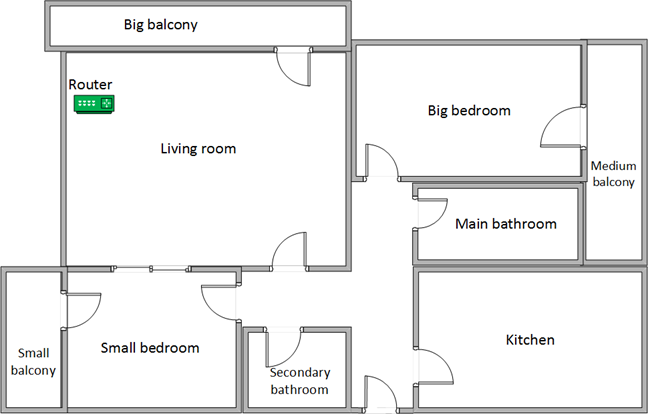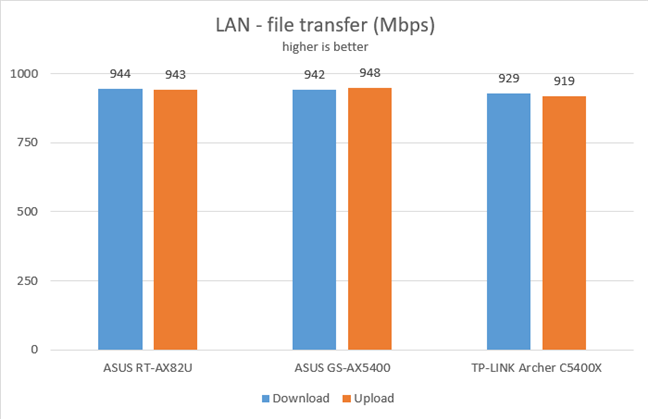
Wireless network performance
Let’s look at the apartment used in our testing: the router is placed in the living room. Unfortunately, the signal strength is not good with most wireless routers in the Kitchen and the Medium balcony.

The apartment in which we tested ASUS GS-AX5400
We have a fast 1 Gigabit Internet connection capable of upload speeds of up to 800 Mbps. We evaluated the Wi-Fi emitted by ASUS GS-AX5400 using the following standards: Wi-Fi 4 on the 2.4 GHz band, Wi-Fi 5, and Wi-Fi 6 on the 5 GHz band.
To get a better idea of the performance offered by ASUS GS-AX5400, we compared it with ASUS RT-AX82U - another AX5400 Wi-Fi 6 router with identical hardware, similar features, price, and marketing positioning. We also compared it to an older Wi-Fi 5 gaming router with the same 5400 Mbps bandwidth TP-Link Archer C5400X, just to get a perspective of whether there are any meaningful differences when switching from a Wi-Fi 5 router to a Wi-Fi 6 one.
We first analyzed the 2.4 GHz band using the Wi-Fi 4 standard and measured the signal strength with NetSpot. The signal strength offered by ASUS GS-AX5400 was pretty good in all the rooms from our test apartment.

The signal strength on the 2.4 GHz band
We used SpeedTest to measure the internet connection speed when connected to the 2.4 GHz band on Wi-Fi 4. The download speed offered by ASUS GS-AX5400 was pretty good in all the rooms of our apartment. In troublesome places like the Kitchen and other rooms where many routers struggle, ASUS GS-AX5400 is the speed champion of this comparison.

SpeedTest - Download speeds on Wi-Fi 4
When we measured the upload speed on the 2.4 GHz band, ASUS GS-AX5400 performed well in all rooms.

SpeedTest - Upload speeds on Wi-Fi 4
We used the PassMark Performance test to transfer data between two computers connected to the network on the 2.4 GHz band using Wi-Fi 4. ASUS GS-AX5400 was the speed champion in all the rooms of our apartment.

Download speeds on Wi-Fi 4
When we measured the upload speed, ASUS GS-AX5400 performed well in all rooms.

Upload speeds on Wi-Fi 4
On the 2.4 GHz band, when using the Wi-Fi 4 standard, ASUS ROG Strix GS-AX5400 is a solid performer with excellent coverage.
For the next set of measurements, we analyzed the performance of the 5GHz wireless band using Wi-Fi 5. We looked at the evolution of the signal strength from room to room. As you can see, ASUS GS-AX5400 was in the middle of the pack.

The signal strength on the 5 GHz band
We used SpeedTest to measure the internet connection speed when connected to the 5 GHz band, using the Wi-Fi 5 standard. In most rooms, the older TP-Link Archer C5400X Wi-Fi 5 gaming router outmatched the download speeds offered by ASUS GS-AX5400.

SpeedTest - Download speeds on Wi-Fi 5
When measuring the upload speed, the situation was slightly different, and the ASUS GS-AX5400 came out on top in many rooms.

SpeedTest - Upload speeds on Wi-Fi 5
We then used the PassMark Performance test to transfer data between two computers connected to the network using Wi-Fi 5. ASUS GS-AX5400 outmatched the other routers in only one room. While it performed well in all the others, it was not the speed champion of this comparison.

Download speeds on Wi-Fi 5
Numbers were mixed when measuring the upload speed on Wi-Fi 5, as you can see below.

Upload speeds on Wi-Fi 5
ASUS GS-AX5400 is a good performer on the 5 GHz band when using the Wi-Fi 5 standard. However, it doesn’t manage to outperform other routers with similar maximum bandwidth.
We remained on the 5GHz wireless band, but we switched to using the Wi-Fi 6 standard. Because the TP-Link Archer C5400X is an older Wi-Fi 5 router, it doesn’t get featured in the comparisons that follow.
We first used SpeedTest to see how fast the internet connection is when using Wi-Fi 6. When measuring the download speed, ASUS GS-AX5400 exchanged blows with ASUS RT-AX82U. There was no clear winner between the two.

SpeedTest - Download speeds on Wi-Fi 6
When measuring the upload speed, ASUS GS-AX5400 was the clear winner in this comparison.

SpeedTest - Upload speeds on Wi-Fi 6
We then used the PassMark Performance test to transfer data between two computers connected to the network using Wi-Fi 6. ASUS GS-AX5400 delivered high-speed downloads everywhere.

Download speeds on Wi-Fi 6
The same happened when measuring the upload speed too. Again, ASUS GS-AX5400 was faster than its similarly-priced counterpart.

Upload speeds on Wi-Fi 6
When using Wi-Fi 6, ASUS ROG Strix GS-AX5400 is an excellent performer, offering fast network transfers and wide coverage.
Wired network performance
It’s time to evaluate the performance we get on Ethernet network connections. When we reviewed the other routers in this comparison, our internet connection was capped at 1 Gbps for the download speed and 500 Mbps for the upload speed. In the meantime, the cap for the upload speed has increased to 800 Mbps. When using SpeedTest, ASUS GS-AX5400 reached the maximum potential of our internet connection, as you can see below.

SpeedTest on Ethernet connections
Then, we ran a network transfer between two computers, using the PassMark Performance test. ASUS GS-AX5400 got very close to the maximum speed possible of 1 Gbps. Then again, the others did as well.

Network transfers using Ethernet connections
ASUS ROG Strix GS-AX5400 has no problems using 1 Gbps internet connections and delivering speeds of up to 1 Gbps for wired networked devices.
USB port
We connected a portable SSD to the USB 3.2 port on the back of the ASUS GS-AX5400 and made some data transfers on it. We measured an average download speed of 722.07 Mbps and an upload speed of 391.90 Mbps. These are excellent speeds that are going to please many users.

How fast is the USB port
Extra features
Security and gaming are a big deal on the ASUS ROG Strix GS-AX5400. This router includes the AiProtection module that provides the following security tools:
- A Router Security Assessment tool that verifies whether your settings are secure. When it finds problems, it proactively informs you and helps you fix things.
- Malicious Sites Blocking – an efficient cloud-based module that blocks access to malicious websites on all the devices connected to your network.
- Two-Way IPS - is a two-way intrusion prevention system that protects your network from spam, DDoS attacks, network attacks, etc. Additionally, it also scans the packets sent from your network to the internet.
- Infected Device Prevention and Blocking – if your network devices get infected and become zombies in malware networks, they are automatically blocked, and you are informed about this problem.
- Parental Controls – cloud-based parental controls that can be used to set rules about internet access for children’s devices. If you are interested in using them, read How to set up Parental Controls on an ASUS router and How to control your child’s internet time on your ASUS router.

The security tools are found in the AiProtection module
There are also many useful gaming features:
- Game Boost - a set of tools that gamers may appreciate:
- Gear Accelerator - allows you to prioritize your gaming devices (consoles, gaming PCs, etc.).
- Mobile Game Mode - with the help of the ASUS Router app, you can enable a specialized game mode that improves your mobile gaming experience.
- Open NAT - a hassle-free way to create port forwarding rules for online games and optimize the routing packets from your gaming console.
- Gaming port - a special LAN port that automatically prioritizes any wired device connected to it. You don't need to configure it. Instead, connect your gaming PC, PlayStation 5, or Xbox console to the gaming port to put it at the top of the queue in your home network.

There are many gaming features on the ASUS GS-AX5400
The list of advanced features doesn’t stop here. You also get:
- AiMesh - you can use the router to build a mesh Wi-Fi network alongside other ASUS routers for increased Wi-Fi coverage.
- Guest Network – you can enable three wireless guest networks with individual security and access settings on each band (2.4 and 5 GHz).
- Adaptive QoS – an easy-to-use Quality of Service feature that you can use to optimize network traffic, including but not limited to online gaming.
- Traffic Analyzer – visual traffic statistics give you a clear picture of how your network is used and by which devices.
- USB Applications - set up your router to use external hard drives or printers through its USB ports. There’s also support for Apple’s Time Machine functionality from macOS. For more information, here’s How to turn your ASUS router into a NAS.
- AiCloud 2.0 - gives you the tools to create your cloud storage service using a hard drive connected to the router.
- Dual WAN - you can use two internet connections at the same time.
- IPv6 – support for IPv6 addresses that are slowly but surely replacing IPv4.
- VPN – you can set the router to work as a VPN server using the following protocols: PPTP, OpenVPN, and IPSec VPN. You can also use it to turn your network-connected devices into VPN-enabled clients without additional VPN software required.
- Instant Guard - a mobile app that helps you establish a VPN connection to your router when you’re on the go, using insecure public Wi-Fi networks.
- VPN Fusion - another new feature available on select ASUS routers. This one allows you to connect to multiple VPN servers simultaneously and assign your client devices to connect to different VPN tunnels. So, for example, your gaming devices can use a gaming-oriented VPN service for playing online, while your work devices can connect to the company’s VPN, all happening simultaneously.
- Network Tools – for analyzing the network and identifying what’s wrong. They are helpful when you need to troubleshoot problems.
- DDNS – a service that allows you to connect to the router from the internet, even if your internet provider assigns you a dynamic public IP address.
- Integration with Amazon’s Alexa, Google Assistant, and IFTTT – you can say things like “Alexa, ask ASUS ROUTER to upgrade the firmware” to perform different tasks. You can also automate tasks that might be repetitive or for devices unable to “talk to each other”, through IFTTT.
The GS-AX5400 Wi-Fi 6 router offers all the latest and greatest features from ASUS, including new additions like VPN Fusion and Instant Guard.
What is your opinion about the ASUS GS-AX5400 router?
Now you know what we like and don’t like about the dual-band ASUS ROG Strix GS-AX5400 gaming router with Wi-Fi 6. You also know its strengths and weaknesses. Before closing this review, share what you think. Are you interested in purchasing this router? If you already own it, what has been your experience with it? Comment below, and let's discuss.


 10.01.2022
10.01.2022 


